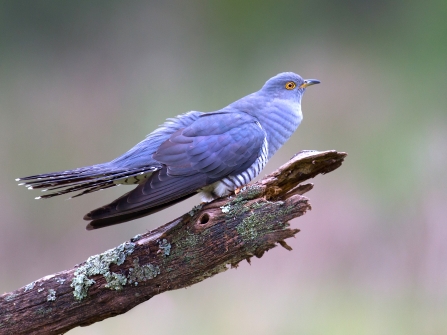
Wildlife to look for in May

Cuckoo
Cuckoos are one of the birds on the British Trust for Ornithology’s ‘Red List’, meaning that their numbers are falling dramatically.
Cuckoos make an astonishing journey each year, flying to Africa for the winter and returning to the UK each spring. The females find another bird’s nest (often a reed warbler or dunnock), remove one of the existing eggs and lay one of their own mimicking the original. She then leaves the ‘host species’ to bring up her chick (which also removes any other eggs from the nest soon after it hatches to ensure the deception is successful).
Cuckoos have been heard in our area this spring. We'd love to know if you've heard a cuckoo near you yet.
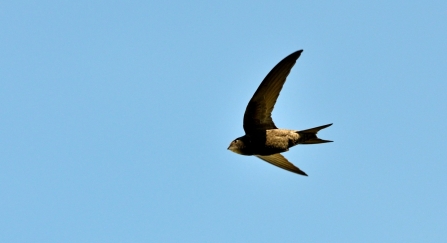
Common Swift Apus apus Norfolk summer - David Tipling/2020VISION
Swifts
Parties of screaming swifts filling the skies are a sure sign that summer is on its way. Did you know they can sleep while still flying!
Have a look at our infographic to help you identify swifts, swallows and martins as they fly overhead.
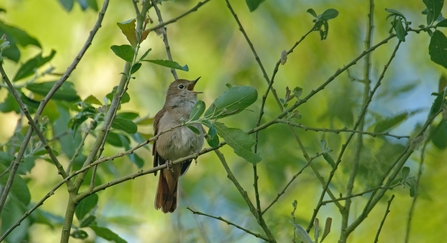
Common nightingale (Luscinia megarhynchos). Photo by Chris Gomersall/2020VISION
Nightingale
Nightingales are also on the BTO Red List as numbers have been declining in recent years. Nightingales spend the winter in Africa, returning here to breed in the spring.
They tend to skulk in thick scrub and thickets so you are much more likely to hear their melodic song than see one. If you're near to these BBOWT nature reserves, listen out for them -Greenham Common and Hosehill Lake (both Berks). Have a listen to a nightingale here:

Holly blue by Amy Lewis
Holly blue
Holly blues are now flying in our gardens and countryside. These small butterflies tend to fly high and quickly, so watch out of them as they zoom past. Despite their name they have a very white underwing and so can appear quite pale, rather than the more bright blue of the common blue, which isn’t yet on the wing.
The females lay their eggs on holly in spring, although they do use other plants, such as ivy, especially later in the season. To help these pretty little butterflies, try to keep some areas of your garden wilder, with ivy growing over trees and fences.

Cockchafers
Look out for these large, noisy beetles called cockchafers or May bugs flying on late spring evenings. If you see one pay close attention to their antennae – males have seven ‘leaves’ while females only have six!
The larvae can spend several years underground before emerging at the end of April or early May. These large beetles fly around looking for a mate. They don’t live long as an adult, just long enough to breed and for the female to lay the next generation of eggs.

Solitary bees
Some of the bees using your garden bug hotel might be red mason bees. The red mason bee is a small, common bee that nests in hollow plant stems, in holes in cliffs, and in the crumbling mortar of old buildings.
As a solitary bee, after mating, each female builds its own nest; she lines each 'cell' with mud and pollen and lays a single egg in each until the cavity is full. The larvae hatch and develop, pupating in autumn and hibernating over winter. This bee is on the wing from late March, and feeds solely on pollen and nectar.
Slow-worm
Despite appearances, the slow-worm is actually a legless lizard, not a worm or a snake! - Its identity is given away by its abilities to shed its tail and blink with its eyelids. You might be lucky enough to spot one in your garden, where it favours compost heaps.
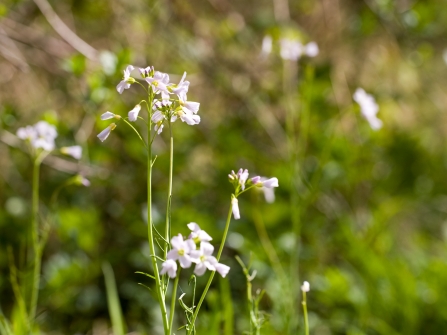
Cuckooflower
This delicate flower generally starts to bloom when cuckoos start to call, hence its name, though sadly these days you’re more likely to see a cuckooflower than hear a cuckoo, which are becoming increasingly rare.
Cuckooflowers, also known as ‘lady’s smock’, grow in damp meadows and woodland rides, and are one of the food plants of orange-tip butterfly caterpillars.

Hawthorn by Philip Precey
Hawthorn blossom
Our hedgerows and roadsides are starting to be drenched in the white blossom of common hawthorn, also known as may, may-tree or mayblossom due to the month its flowers peak in.
This shrub not only looks beautiful at this time of year, but is also important for a wide range of wildlife. Around 300 invertebrates are associated with hawthorn, many of which are the caterpillars of moths; with evocative names such as pear leaf blister, rhomboid tortrix and light emerald. In autumn the bright red haws are important as a food source for many species including small mammals and birds such as redwing and fieldfare.
Hawthorn has long been a part of our link to the countryside and nature. It is a pagan symbol of fertility and has ancient associations with May Day. It was the ancestor of the maypole and its leaves and flowers the source of May Day garlands as well as appearing in the wreath of the Green Man.
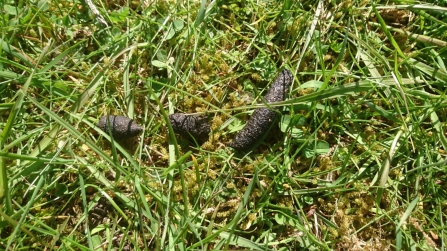
Hedgehog poo by Debbie Lewis
Hedgehogs
You might be lucky enough to find signs of hedgehogs in your garden. Perhaps you’ll see or hear them feeding on a warm spring evening at dusk; or more likely you’ll spot some hedgehog droppings the following morning. The poo in the picture was found in a local cemetery, which is quiet and full of hedgehog’s favourite food, slugs, snails and worms. Hedgehogs can travel an amazing 1 – 2km a night.
Hedgehogs have suffered from significant population declines, mostly as a result of habitat loss and increased used of pesticides. But, unusually for wildlife our gardens and parks provide a safe refuge for hedgehogs. So there is much you can do to help stop this decline.
Plan your garden to have areas of tall grass for hedgehogs to forage and hide in during the summer months and piles of wood for hibernating over the winter. You can also ensure that they can roam far and near by creating holes in fences, which would otherwise create a barrier to movement. And of course you can feed them with specialist hedgehog food, so that you can sit back and enjoy watching them tuck in, just as everyone else is going to sleep and our night-time wildlife is waking up.
Stay connected with others
Join our online community, linked by a love of nature and wildlife. Follow us on Twitter, Facebook and Instagram. We share lots of beautiful photos of local wildlife, ideas to enjoy nature and ways to help wildlife near you.
You can join our friendly Facebook group to share photos of wildlife that you’ve seen in your garden, get help identifying any you’re not sure about, and share ideas for getting your daily dose of nature.
Stay up-to-date with our work
Sign up below to receive the latest news from BBOWT, tips about how you can help wildlife, plus information on how you can get involved.

